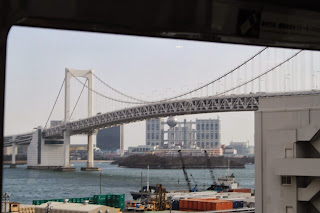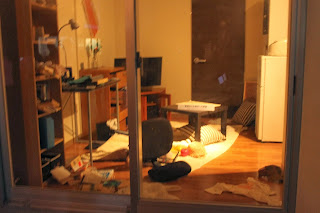It seems almost pointless to travel to impressive water/disaster management locations by myself, since I learned we were to visit the Tokai disaster prevention park on Odaiba as part of our classes. It was a welcome diversion from the two week course in Tokyo, even if it did mean additional travel to the daily four hours. The best part of it was how we have to travel using subways, to classes that teach us in minute detail how unsafe the subways are...
In any case, together with the BRI students, we took the subway and magnet train to Odaiba, where a new Gundam exhibition will be opened soon. We got a lecture from the director of the complex in the main command room, and got to see places not normally open to the public at all. Our big group was divided into two smaller ones, and mine got to go on the formerly heartbreaking earthquake simulation tour with Nintendo DS. Even with this
news, having seen the simulation before made it slightly less terrifying. Of course I had to score a 100% this time, but the real question is, what will happen during a real disaster?
Room with furniture attached to the wall:
Room with furniture not attached to the wall:
The second location our group went to was inside the operations room. Our professor pointed out what was on the name tag of the desk we were sitting at. I could read 'Honbuchou', but what does it mean? President! Main person in charge...! The good news was that the phone was definitely working, a dial tone sounded... In case of a major disaster, the military also gets its own room next door to this room, but it is furnished more sober as they bring their own equipment. Finally we went down under the building and got to see the special anti-shaking architecture allowing the center to function despite earthquakes. It was a rare treat to be able to go to these places.




Meeting up with the much faster other group upstairs, we found some presents on our desks. As the stocked foods of the center were running close to expiration date, they were giving them away while new food was being stocked. The initial happiness of having some preparatory goods faded slightly after that announcement. Having eaten the items by now, all students I have spoken to agree the taste of the food is another reason not to want to have an earthquake. It was rather dry and flavorless, and 200 calories is not that much for a meal. We are now completing our earthquake survival kit with more edible foods, and we are planning to have a restock party at the first expiration date.














